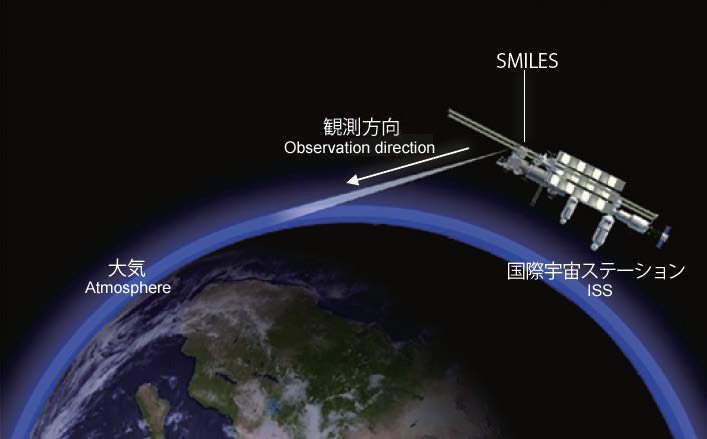
| | 1 | 2 | 3 | |
SMILES Full of “First Times”
Are you aware of the SMILES (Superconducting Submillimeter-Wave Limb Emission Sounder)? Above the troposphere (0~15km) where there will be weather phenomena such as typhoon and thunder, there covers the stratosphere (15~50km) with the ozone layer. The ozone layer is playing an important role in absorbing ultraviolet which is harmful for creatures on the ground. However, it was severely depleted by anthropogenic substances (generally chlorofluorocarbons called Freon). Afterwards, an international treaty (the Montreal Protocol in 1987 and its amendments) was adopted to regulate the emission of ozone depleting substances and it is gradually taking effects. However, predictions on the recovery of the ozone layer by various research institutes differ greatly with each other, and there are concerns on the effects of global warming on the concentration of ozone. To know the situations correctly and to evaluate the future, it is required to perform the high-sensitivity global observations of the stratospheric ozone along with the trace gases (the other molecules except dinitrogen and hydrogen), and the SMILES was responsible for that (Figure 1).
|
SMILES was launched on 11th September 2009 by the H-IIB testing rocket, carried to the International Space Station (ISS) on the 25th by the HTV “Kounotori” testing vehicle and was attached to the outside platform of the Japanese Experiment Module “Kibo”. It was as well supposed to conduct the first space technology demonstration of the 4K mechanical cooler (absolute temperature 4K= -269°C) and the superconducting mixers for detecting the weak submillimeter waves from the trace gasses . I felt concerned whether it was able to conduct the observation with so many “first times”, but during a half year since the October of 2009, it has conducted the atmospheric observation with the highest-sensitivity among the observations so far and has brought us a lot of new knowledge in the atmospheric science field. In this article, I’m going to introduce two researches on the achievements of SMILES and give an overview on the next observation plan.
Diurnal Variation of the Stratosphere Ozone Revealed
As mentioned above, the stratospheric ozone is preventing creatures on the ground from the harmful ultraviolet and is additionally taking effects on the heat balance of the earth, playing a very important role in the formation of the climate. Therefore, we have been monitoring the ozone through many methods so far.
On the other hand, Takatoshi Sakazaki, the Japan Society for the Promotion of Science Research Fellow (PD) of Research Institute for Sustainable Humanosphere, found that there is a diurnal variation in the ozone in the stratosphere (Figure 2) with the high-sensitive and non-sun-synchronous observation data (*1 ), which is the features of SMILES. Additionally, according to the analysis of chemical transport model (one of the numerical models for calculating the distribution and variation of the chemical substances in the atmosphere), they found that for the diurnal variation of the stratospheric ozone is not only the photochemical change (influences from the diurnal variation of sunlight) but is also influenced by the dynamics effects (vertical transport effects from the updrafts and downdrafts following the atmospheric tide).
|
The result is important because the mean deviation of the diurnal variation reaches 8% at most and we cannot ignore this amount for evaluating the trend analysis of ozone concentration. Since the observation data from almost all the satellites on the sun- synchronous orbits or the scheduled balloon and ground-based observations used for trend analysis has a deviation in observation time, there is a need to make corrections in regard of the diurnal variation. This result has been published on the journal of geophysics, “Journal of Geophysical Research (JGR)”. Additionally, the new knowledge about the variation in ozone concentration has been included in the “Scientific Assessments of Ozone Depletion: 2014” published by United Nations Environment Programme (UNEP) and World Meteorological Organization every 3 or 4 years which describes the current situation and forecast of ozone depletion.
(*1) Non-sun-synchronous observation data: while the satellite is on a non-sun-synchronous orbit, it is able to conduct observations at different local time, so as to be able to investigate the diurnal variation phenomenon.
| | 1 | 2 | 3 | |



Comments are closed.